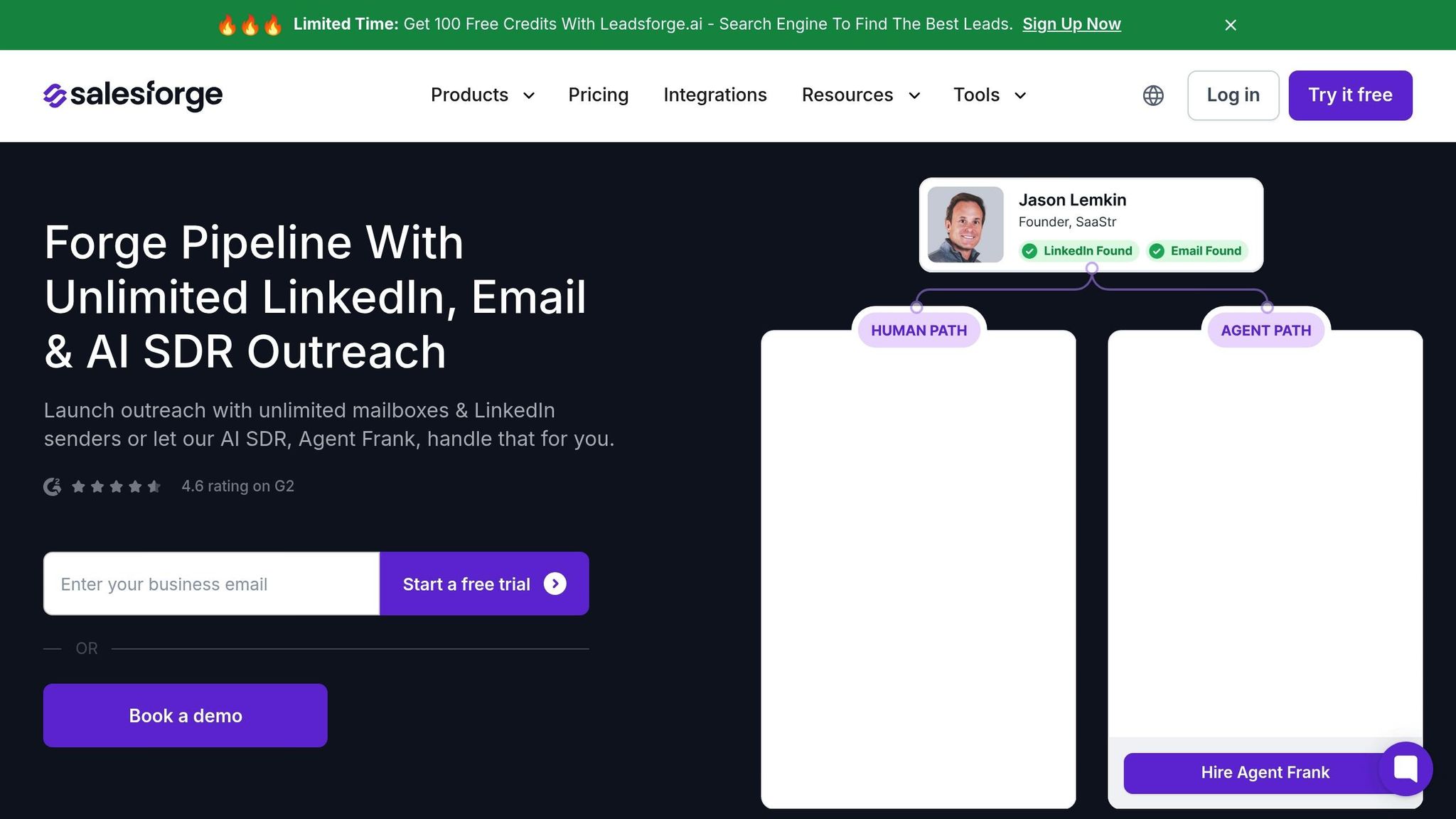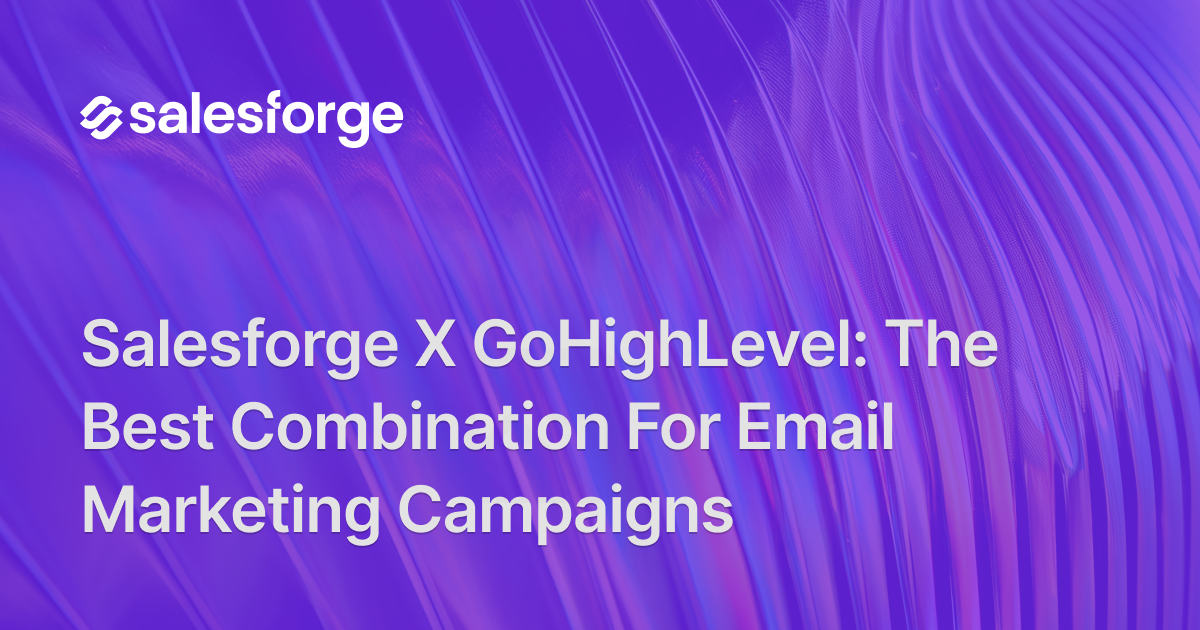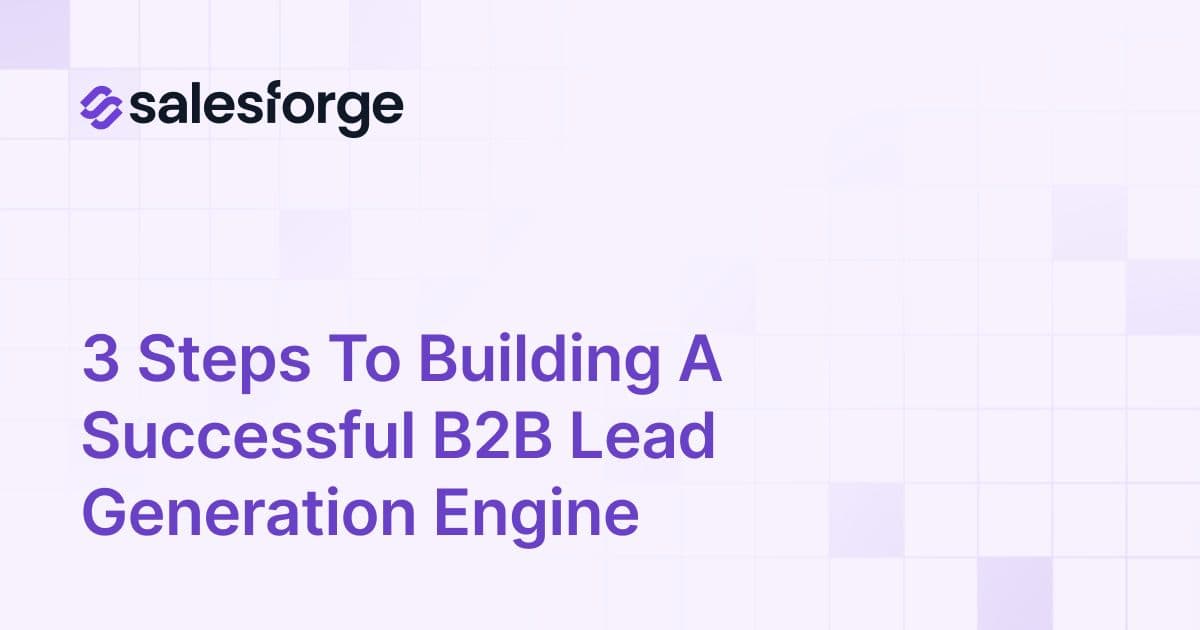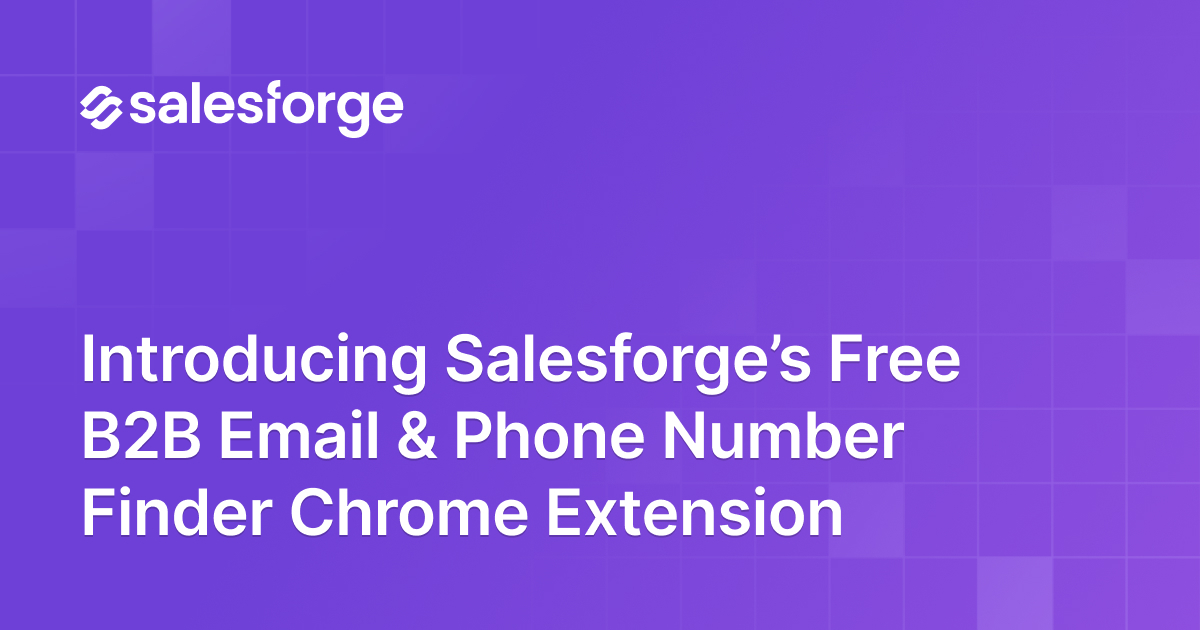How AI Powers Scalable Prospecting Workflows
AI is transforming sales prospecting by making it faster, more efficient, and personalized at scale. Traditional methods are slow, costly, and limited in scope, but AI tools analyze thousands of data points in minutes, enabling sales teams to handle more leads with higher accuracy and better results.
Here’s what AI-driven prospecting brings to the table:
- Faster Lead Processing: Analyze 5,000–10,000 data points per lead in 5–10 minutes (vs. 30–60 minutes manually).
- Higher Conversion Rates: AI boosts lead conversion rates to 12.5% compared to 9.3% with manual efforts.
- Cost Savings: Reduce cost-per-lead from $20–$50 to $5–$15.
- Scalability: Handle 100–150 leads daily, with advanced setups managing over 1,000 leads.
- Better Personalization: AI creates tailored, human-like messages for each prospect, improving engagement.
Tools like Salesforge simplify this process by automating lead generation, email warm-up, multi-channel outreach, and meeting scheduling. Their AI SDR, Agent Frank, manages the entire prospecting cycle, saving time and driving results.
AI prospecting isn’t just about automation - it’s about smarter, data-driven workflows that let sales teams focus on closing deals instead of repetitive tasks.
Setting Up an AI-Driven Prospecting Workflow
Requirements for Success
To make AI prospecting work effectively, it all starts with knowing your audience. Identify their demographics, behaviors, pain points, and buying signals. AI tools need clear direction to target the right people.
Next, integrate your CRM with AI tools to ensure smooth data flow and real-time insights. Without this connection, the AI lacks the context it needs to function effectively. Most successful workflows rely on clean, synchronized data between your CRM, marketing automation tools, and prospecting platforms.
Speaking of data, its quality is critical. Outdated or incomplete contact information can derail your efforts, as AI will simply speed up the process of reaching the wrong audience. Invest in trustworthy data sources and implement regular validation and enrichment processes to keep your data accurate and up-to-date.
Email deliverability is another key factor. Without proper email authentication and dedicated IPs, your AI-generated messages may never reach their intended recipients. Make sure you have SPF, DKIM, and DMARC records in place, along with dedicated IP addresses and email warm-up routines.
Once these foundational elements are in place, configure them within your AI tools to create an operational prospecting workflow.
Configuring AI Tools for Prospecting
Set up your AI tools to automatically enrich leads with essential details and validate email addresses to maintain your sender reputation. This might include pulling in company information, recent news, social media activity, and even details about the prospect's technology stack.
Building multi-channel outreach sequences is another crucial step. Coordinate email and LinkedIn outreach with specific triggers to ensure your messaging is both timely and consistent. For instance, if a prospect doesn’t respond to your initial email within five days, the system could automatically send a LinkedIn connection request with a personalized note.
Personalization is where AI can truly shine, but it requires clear guidelines. Define which data points should influence the tone and content of your messages, whether you want a formal or casual approach, and ensure compliance with any relevant regulations. Specific instructions lead to tailored, effective messaging, while vague parameters result in generic, uninspired output.
A great example of this in action is Salesforge, a platform that simplifies the setup and execution of an AI-driven prospecting system.
Using Tools Like Salesforge

Salesforge makes AI-powered prospecting more accessible by offering an integrated setup that includes features like multi-mailbox management through Primebox™ and automated email warm-up with Warmforge. Instead of manually increasing send volumes over weeks to establish a sender reputation, the platform handles this process in the background.
It also simplifies multi-channel sequencing with built-in LinkedIn integration. You can create workflows that seamlessly move prospects between email and LinkedIn based on their engagement. For example, if someone opens your email but doesn’t respond, the system can automatically send a LinkedIn connection request referencing your previous email.
The AI personalization engine takes things further by leveraging your data to craft unique, human-like messages for each prospect. It goes beyond basic mail merge fields, analyzing prospect details to create messages that feel tailored and genuine - something that previously required entire teams of writers to achieve.
Finally, Salesforge’s AI SDR, Agent Frank, completes the process by automating lead identification and booking meetings. This aligns perfectly with a fully automated prospecting strategy, saving time and delivering results at scale.
Running Scalable Outreach with AI
Once your AI system is set up, it’s time to put it to work. AI takes outreach to a whole new level by automating tasks like personalization, lead management, and follow-ups - tasks that often overwhelm even the most seasoned sales teams.
AI-Driven Personalization at Scale
Before AI, manual personalization meant sales teams could only handle 20–30 quality outreach attempts a day. AI flips this on its head. By analyzing prospect data in real time, it creates personalized messages that feel like they’re crafted for each individual, even when you’re reaching thousands of prospects at once.
How does it work? AI draws from a variety of data points - like recent company news, social media updates, job changes, funding rounds, or industry trends - to craft messages that are relevant and timely. For businesses expanding internationally, AI’s multilingual capabilities are a game-changer, enabling you to send messages in your prospect’s preferred language with native-level fluency.
You can even train AI to reflect your brand’s unique voice. Over time, it learns your tone, style, and key messaging, ensuring that every interaction is consistent and engaging. This level of personalization doesn’t just grab attention - it sets the stage for smooth lead management and follow-up automation.
Automating Lead Management and Follow-Ups
AI doesn’t stop at personalization. It simplifies the entire journey of each prospect, automating multi-touch campaigns across different channels. Forget manually tracking where each prospect is in your sequence - AI takes care of it all, adjusting lead statuses in real time based on how prospects engage.
Dynamic lead scoring is a standout feature. As prospects interact - whether it’s opening an email, visiting your website, or engaging on LinkedIn - their score updates instantly. This allows for customized follow-ups: highly engaged leads might get a direct meeting invite, while less active ones are nurtured until they’re ready to move forward.
Scheduling meetings? AI handles that, too. It can pick up on buying signals in responses, suggest meeting times, send calendar invites, and even manage scheduling tasks. This eliminates delays and speeds up the sales process.
Timing follow-ups is another area where AI shines. Instead of rigid schedules, it analyzes engagement patterns to send follow-ups when prospects are most likely to respond. This ensures your outreach is not just timely but impactful.
Comparing AI Tools for Outreach
When it comes to AI tools for prospecting, not all are created equal. Salesforge stands out for its multi-channel approach and robust features. It combines advanced personalization with seamless integration across email and LinkedIn, enabling sophisticated outreach sequences.
Some of its standout features include unlimited email warm-up powered by Warmforge, built-in email validation, and the AI SDR Agent Frank, which automates everything from lead generation to meeting scheduling. For high-volume operations, Salesforge’s all-in-one design makes it easy to manage large-scale outreach while maintaining the personal touch that drives engagement and conversions.
These scalable outreach strategies don’t just improve efficiency - they lay the groundwork for better workflow performance in the steps ahead.
Optimizing Your Prospecting Workflow
To make the most of AI prospecting, it's essential to focus on continuous improvement. This means refining your process to enhance performance, ensure emails land in inboxes, and achieve a better return on investment. Once email deliverability is under control, the next step is using AI-driven analytics to fine-tune your workflow.
Email Deliverability and Compliance
For emails to convert prospects, they first need to reach their inbox. Achieving reliable email deliverability involves both a strong technical foundation and ongoing upkeep.
- Warming up your domain: If you're using a new domain or mailbox, you can't jump straight into high-volume sending. Doing so can trigger spam filters and damage your reputation. Tools like Warmforge, included with Salesforge, help by gradually increasing your sending volume, building trust with email providers.
- Protecting your domain reputation: Use separate domains for prospecting to shield your primary business domain. Ensure proper email authentication by setting up SPF, DKIM, and DMARC protocols. Monitoring your sender score regularly is also critical for avoiding blacklists.
- Validating email addresses: Bounced emails harm your reputation. Automated email validation tools, like those in Salesforge, can filter out invalid addresses, role-based emails, and disposable accounts, ensuring your list stays clean.
- Staying compliant with regulations: Laws like the CAN-SPAM Act require clear sender information, honest subject lines, and easy opt-out options. If you're targeting European prospects, GDPR compliance is non-negotiable. AI tools can help by automatically adding disclaimers and managing opt-outs within your email sequences.
Using AI Analytics for Continuous Improvement
AI analytics unlock insights that traditional methods simply can't provide. By analyzing performance and engagement data, you can make smarter decisions to refine your campaigns.
- Tracking engagement: AI can analyze how prospects respond to your emails, uncovering what works (and what doesn’t). It can identify effective personalization tactics, measure sentiment, and track behavior across multiple touchpoints.
- A/B testing at scale: With AI, you can test different strategies - like email length, personalization styles, or sending times - on thousands of prospects at once. These tests reveal what resonates most with different industries or audience segments.
- Streamlining follow-ups: AI can categorize replies, flagging those that need immediate attention and filtering out less urgent responses. This saves time and ensures no potential lead slips through the cracks.
- Predicting outcomes: Predictive analytics can identify which prospects are most likely to convert and which outreach sequences perform best for specific industries. This helps you focus your efforts where they’ll drive the most results.
Getting Better ROI with Tools Like Salesforge
Using platforms like Salesforge can amplify your results by combining analytics with powerful tools to streamline your workflow.
- Unified inbox management: Primebox™ consolidates all your email accounts into one interface. AI prioritizes urgent responses and even suggests replies to save time.
- ESP matching: To avoid overloading a single email provider, AI automatically distributes your outreach across multiple providers. If one provider has issues, the others continue operating smoothly.
- Multi-channel sequencing: Coordinating email campaigns with LinkedIn outreach ensures consistent messaging across platforms, often leading to higher response rates than single-channel efforts.
- Cost savings through consolidation: Instead of juggling separate tools for warm-up, validation, personalization, and analytics, platforms like Salesforge bundle these features into one subscription, cutting costs.
- Optimizing spending: AI tracks metrics like cost-per-lead and cost-per-meeting, helping you decide which campaigns deserve more investment and which ones need tweaking.
Think of optimization as a continuous journey, not a one-time task. Regularly analyzing data and adapting based on AI insights ensures your prospecting workflow evolves alongside your business growth.
Automating the Full Prospecting Cycle with AI SDRs
Automating the entire prospecting cycle with AI Sales Development Representatives (SDRs) takes scalability to the next level. While streamlining individual parts of the process can be effective, the real magic happens when the entire workflow - end-to-end - is automated. This is where AI SDRs transform the way sales teams generate and qualify leads.
What is an AI SDR?
An AI SDR is software designed to mimic the work of a human SDR, handling tasks like identifying prospects, tailoring outreach, and scheduling meetings. Unlike traditional automation tools that require constant manual oversight, AI SDRs operate autonomously, making decisions based on data and preset rules.
Think of an AI SDR as a digital sales team member. It’s always on, never takes a day off, and can manage thousands of prospects simultaneously. Unlike basic automation tools, AI SDRs go beyond the surface. They research leads, craft personalized messages, schedule follow-ups, and adjust strategies based on engagement - all without human intervention.
This technology solves a major challenge in sales prospecting: balancing scale and personalization. Human SDRs excel at crafting personalized outreach but often struggle to handle large volumes. Basic automation handles the volume but lacks the finesse needed for effective personalization. AI SDRs bridge this gap, delivering tailored outreach at scale.
Features and Benefits of AI SDRs
AI SDRs bring capabilities that would otherwise require an entire sales team to execute manually. They work tirelessly, identifying leads and running campaigns while your human team focuses on closing deals.
- 24/7 prospecting: AI SDRs never stop working. While your competitors’ teams are offline, these digital reps continue identifying leads, sending personalized messages, and nurturing prospects through automated sequences. This ensures your pipeline remains active around the clock.
- Multi-language support: AI SDRs can craft high-quality outreach in dozens of languages, opening up global markets without needing multilingual staff on your team.
- Intelligent lead scoring: These systems analyze engagement signals to prioritize leads, ensuring your sales team focuses on the most promising opportunities.
Take Salesforge’s Agent Frank as an example. This AI SDR handles the entire process - from lead generation to booking meetings - and operates in over 20 languages. It’s fully customizable, adapting to your industry, messaging style, and target audience. Unlike generic templates, it learns your company’s voice and applies it consistently across all interactions.
Agent Frank also comes with integrated contact search, giving you access to a database of over 500 million contacts. This eliminates the need for separate prospecting tools, streamlining everything from identifying leads to initial outreach.
Comparison of AI SDR Solutions
The AI SDR market has grown rapidly, with various platforms offering different levels of automation. Choosing the right solution depends on your specific needs and budget.
| Feature | Agent Frank | Traditional AI SDRs | Basic Automation |
|---|---|---|---|
| Lead Generation | Integrated contact search | Often requires integration | Manual list building |
| Personalization Depth | AI-driven, context-aware | Template-based with variables | Static templates |
| Multi-channel Support | Email + LinkedIn integrated | Often single-channel | Limited channels |
| Language Support | 20+ languages | Varies by platform | Usually English only |
| Meeting Booking | Fully automated | Partial automation | Manual scheduling |
| Cost per Contact | $0.25 | $0.50–$2.00+ | Lower upfront, higher labor costs |
Automation depth is a key differentiator. For example, Agent Frank automates everything from researching prospects to confirming meetings, while many competitors require manual input at multiple stages. This reduces efficiency and adds labor costs.
Integration capabilities also matter. Agent Frank integrates seamlessly with Salesforge’s platform, offering tools like email warm-up, validation, and multi-channel sequencing without extra subscriptions. Other platforms often require separate tools for these functions, increasing complexity and costs.
Customization flexibility is another critical factor. While some platforms rely on rigid templates, Agent Frank allows deep customization of messaging styles, follow-up sequences, and lead qualification criteria, making it adaptable to your unique needs.
Support and onboarding can make or break your experience with AI SDRs. Agent Frank includes a dedicated account manager, real-time support via Slack, and guidance on industry best practices. This hands-on approach ensures faster implementation and better results compared to self-service platforms.
Finally, consider the total cost of ownership. While some solutions may have lower upfront costs, hidden expenses like integration fees, training, and additional tools can add up. Comprehensive platforms like Agent Frank often deliver better long-term value despite higher initial pricing.
Performance transparency is also essential. The best AI SDRs provide detailed analytics on engagement, message performance, and conversion rates, enabling continuous optimization. Less advanced solutions may lack this level of insight, making it harder to refine your campaigns.
Conclusion: Scaling Prospecting with AI
AI is reshaping the prospecting landscape, turning what was once a manual, time-intensive process into a streamlined, data-driven strategy. This shift doesn't just improve efficiency - it makes scaling outreach while maintaining personalization a reality.
Key Takeaways
One of the biggest advantages of using AI in prospecting is its ability to combine scale and personalization. Traditional methods often forced sales teams to choose between sending generic messages to a wide audience or creating personalized outreach for a limited number of leads. AI eliminates this trade-off by enabling both.
Unlike basic automation, which handles isolated tasks, comprehensive AI workflows manage the entire prospecting cycle. From identifying qualified leads to scheduling meetings, these workflows reduce the need for manual intervention and ensure a consistent approach at every stage.
AI also enhances engagement by integrating multi-channel outreach and tailoring communication to individual prospects. By relying on data-driven insights, AI transforms prospecting into a measurable process, constantly refining strategies to boost results.
With AI taking care of repetitive tasks, the cost per qualified lead drops significantly. This allows sales teams to focus their efforts on high-value activities like building relationships and closing deals. Tools like Salesforge exemplify how AI can make this transformation seamless.
The Role of Tools Like Salesforge
Salesforge is a great example of how an AI platform can simplify and scale prospecting for teams of all sizes. By integrating multi-channel outreach and ensuring strong deliverability, it centralizes the entire process.
Its standout feature, Agent Frank, takes automation to a new level. At just $0.25 per contact, Agent Frank can handle over 2,000 contacts monthly, managing everything from lead generation to booking meetings. With access to a database of over 500 million contacts, it eliminates the need for multiple tools, streamlining workflows and saving time.
Additionally, Salesforge supports over 20 languages, opening doors to global markets without requiring teams to hire multilingual staff.
Next Steps for Sales Teams
Now that the benefits of AI-driven prospecting are clear, it's time to rethink your team's approach. Start by reviewing your current workflow to identify areas where manual processes slow you down. Tasks like lead research, message drafting, and follow-up management are ideal starting points for AI integration.
Test AI personalization with a small segment of your prospect list. Compare the performance of AI-generated messages with your existing templates to see how well it aligns with your audience.
Gradually introduce multi-channel outreach. Begin with email campaigns, then add LinkedIn or other platforms once your messaging is fine-tuned. This phased approach ensures smoother adoption and better engagement.
Consider investing in platforms like Salesforge that combine automation, deliverability, and prospecting in one place. A unified solution reduces the hassle of managing multiple tools and often delivers better results.
As AI-powered prospecting generates leads at scale, set up lead scoring and qualification systems early. This ensures your team focuses on the most promising opportunities right from the start.
The future of prospecting belongs to teams that embrace AI while keeping human oversight for strategic decisions and relationship building. By automating repetitive tasks, your team can focus on what they do best - connecting with prospects and closing deals.
FAQs
How does AI create personalized messages for prospecting without sacrificing scalability?
AI has revolutionized the way businesses approach prospecting by making it possible to personalize outreach at scale. With the help of advanced algorithms and machine learning, messages can be tailored to individual leads in just seconds. This means even high-volume outreach can feel relevant and engaging, creating a more meaningful connection with potential customers.
Take platforms like Salesforge, for example. They combine AI-powered personalization with practical tools like email validation, multilingual message generation, and automated workflows. These features let sales teams handle large-scale outreach without losing the human touch, leading to stronger engagement and improved outcomes.
How can I ensure strong email deliverability when using AI for prospecting?
To keep your email deliverability strong when using AI-driven prospecting, make sure your SPF, DKIM, and DMARC records are set up correctly. These records authenticate your emails and help prevent them from being marked as spam. On top of that, keep an eye on your sender reputation, minimize bounce rates, and work with clean, verified email lists.
When it comes to your messaging, focus on creating personalized and relevant emails that genuinely connect with your audience. Avoid using overly promotional or spam-like language. Tools like Salesforge can be a game-changer here, offering features such as email validation and warm-up services. These can help ensure your emails make it to inboxes instead of getting stuck in spam folders.
How can AI help improve prospecting strategies and boost engagement rates?
AI is reshaping the way businesses handle prospecting by digging into engagement patterns, firmographics, and intent signals to pinpoint the most promising leads. This approach can cut manual research time by as much as 50%, while also boosting conversion rates. On top of that, AI takes personalization to the next level by analyzing customer behavior, crafting customized messages, and even predicting how prospects are likely to respond. The result? Better engagement and a healthier sales pipeline.
What’s more, AI tools get smarter over time. By learning from real-time interactions, they fine-tune prospecting strategies to keep outreach efforts sharp and scalable. This not only drives higher engagement rates but also streamlines the entire sales process, making AI a powerful tool in today’s prospecting workflows.






